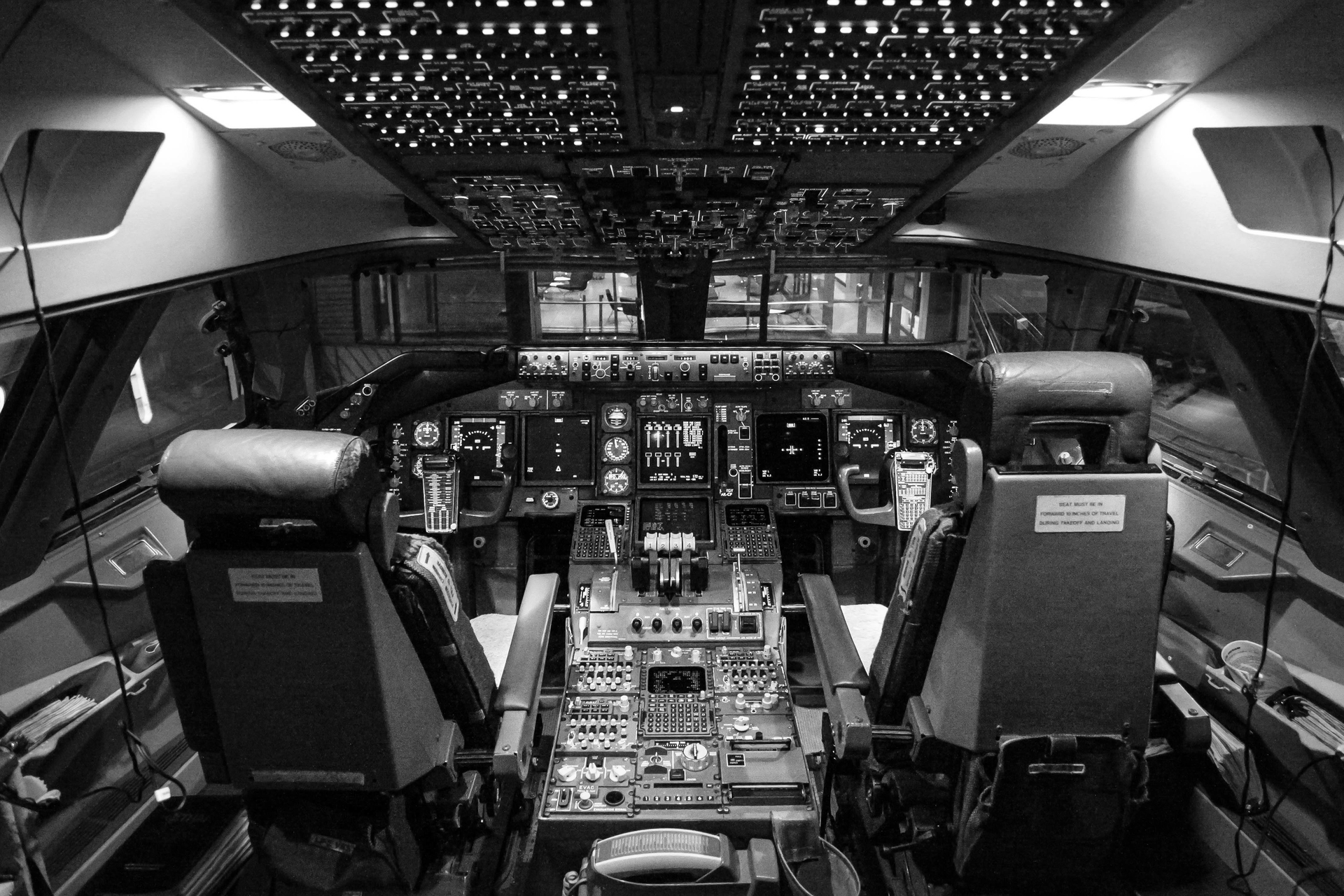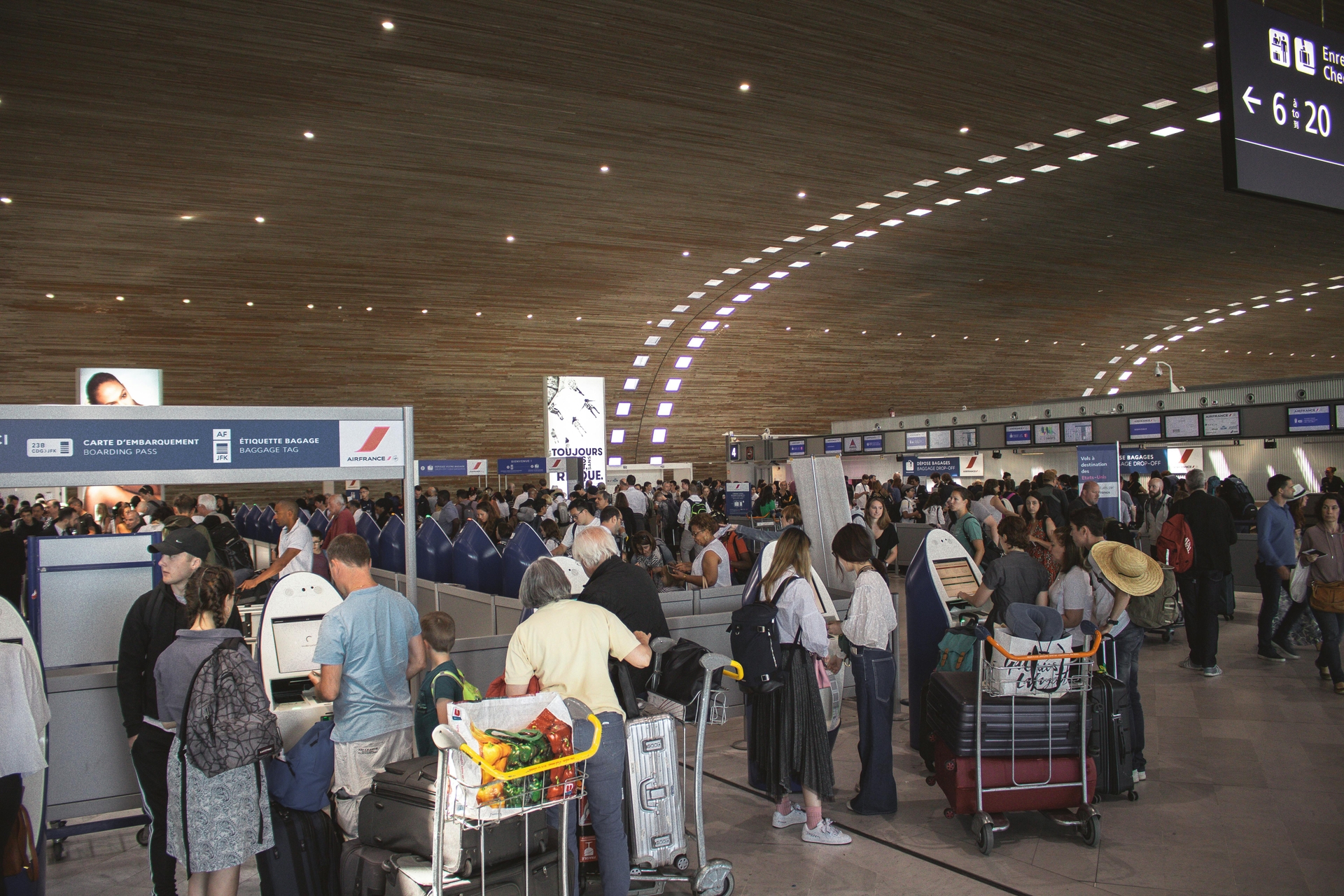
AeroGenie — Your Intelligent Copilot.
Choosing the Right Aircraft Parts with Damage Tolerance Analysis
October 02, 2025
The future of aviation safety is all about the parts. Authentic, traceable parts bring optimal damage tolerance and performance to fleets for maximum safety and procurement efficiency.
When thinking about aircraft safety, most people envision oxygen masks and rescue gear, or cutting-edge design innovation. But safety hinges on the reliability of every component installed, from every nut and bolt to the most sophisticated of engines.
Each aircraft part has its own service life. Damage tolerance analysis (DTA) is a major factor in how long these various parts will last. DTA evaluates how different structures behave under stress, such as when cracks, holes, and other flaws inevitably form.
While older thought models dictated that parts shouldn’t fail—or that they should be replaced at regular intervals or as soon as the “cracks” began to show—DTA takes a different approach. With DTA, maintenance and repair teams assume that parts degradation will inevitably occur and that planes can fly with some visible damage—as long as it’s detected and monitored within certain thresholds (Skybrary).
This more nuanced approach changes how procurement decisions are made. Beyond cost and availability, teams must consider fatigue and fracture mechanics standards. With increasingly aging fleets, higher utilization cycles, and more composite materials in the mix, DTA plays a vital role in purchasing decisions for regulatory approval and operational continuity.
Understanding damage tolerance analysis in aviation
Damage tolerance (DT) is a design and maintenance philosophy that assumes cracks, flaws, and corrosion will emerge in aircraft components over time (Skybrary).
This philosophy emerged in the 1970s, replacing the “fail-safe” and “safe-life” approaches that had dominated earlier decades.
- Fail-safe method: Redundant load paths were expected to prevent collapse if a part failed.
- Safe-life approach: Assumption that parts could be retired after a fixed number of cycles, regardless of condition.
Both approaches left gaps. Fail-safe did not account for hidden fatigue growth, while safe-life underestimated the variability of parts degradation under different conditions. DTA filled these gaps by embedding inspection and monitoring into the safety equation.
Regulators quickly formalized this shift. The U.S. Federal Aviation Administration codified DTA requirements in Advisory Circular 25.571-1A, which outlines how airplanes must demonstrate the ability to tolerate fatigue, corrosion, and accidental damage until it can be found and corrected.
This advisory remains the cornerstone for modern aircraft certification, ensuring that structures are designed and maintained under the assumption that imperfections will appear.
Today, damage tolerance analysis is an industry-wide safeguard. DTA mandates that parts and assemblies endure real-world conditions such including cyclic stress, vibration, and harsh environments, thus ensuring that operators and suppliers focus on life-cycle safety rather than short-term fixes.
FAA and international regulatory frameworks
The Federal Aviation Administration (FAA) has made fatigue and damage tolerance one of its most technically demanding disciplines.
According to the agency, it requires assessing how materials and structures respond to mission cycles, especially repeated or fluctuating stresses that drive fatigue and crack growth (FAA). This work integrates metallurgy, fracture mechanics, nondestructive inspection (NDI), and probabilistic modeling to set the design and inspection standards for every certified aircraft.
Advisory Circular 25.571-1A remains the primary guide for U.S. manufacturers and operators. Its requirements for damage tolerance extend across fuselage skins, wings, engine mounts, landing gear, and other components where undetected cracks could have severe consequences.
Internationally, regulators have aligned standards with the FAA approach while tailoring requirements to country-specific or regional oversight.
The European Union Aviation Safety Agency (EASA) mirrors FAA’s directives but often emphasizes harmonization across multiple national carriers operating diverse fleets. The UK Civil Aviation Authority (CAA) mandates fatigue and DTA evaluations for aging aircraft under additional airworthiness specifications (Airframe Designs).
The push for global consistency has been driven by regulating bodies and numerous safety incidents where part fatigue went undetected. After the Aloha Airlines Flight 243 accident in 1988 (FAA), regulators worldwide tightened requirements for full-scale fatigue testing and damage tolerance inspections.
Evolution of damage tolerance philosophy
The shift toward damage tolerance represents one of the most significant safety advances in aviation design. In the post–World War II era, safe-life principles dominated. Components were simply assigned fixed lifespans based on test data and retired before presumed failure. However, as aircraft grew larger and more complex, the variability of operational conditions made this approach insufficient.
The turning point came as commercial jets aged and fatigue-related accidents highlighted the limitations of safe-life and fail-safe assumptions. Failures could occur earlier than predicted, or redundancy could mask problems until they spread across multiple load paths, as with the 1988 Aloha Airlines incident.
Damage tolerance emerged as a pragmatic philosophy: assume cracks exist, design structures to withstand them, and create inspection programs to catch growth before failure. This approach required new methodologies, such as fracture mechanics analysis and probabilistic life prediction, that could quantify crack initiation and growth under real operating conditions (ScienceDirect).
Since the 1970s, the philosophy has continued to evolve with advances in nondestructive inspection technologies, digital modeling, and composite materials. Today, damage tolerance is not just about responding to cracks but anticipating them. Predictive analytics and health monitoring systems are allowing airlines and suppliers to track component health in real time, turning damage tolerance into a proactive rather than reactive strategy.
Key principles of damage tolerance analysis
Damage tolerance analysis (DTA) is built on several foundational principles that guide both aircraft manufacturers and parts suppliers.
Fracture mechanics
It assumes that cyclic loading—repeated stresses during takeoff, cruise, landing, and pressurization cycles—accelerates damage (FAA).
To manage this, engineers use fracture mechanics to model how cracks propagate under varying loads. Crack growth rate data, typically expressed in stress intensity factors, allows prediction of how long a crack can remain stable before reaching critical length.
Inspectability requirement
A second principle is the inspectability requirement. Structures must be designed so that cracks can be detected using nondestructive inspection (NDI) methods before they reach unsafe sizes.
This helps ensure that inspection intervals are aligned with actual crack growth rates, creating a buffer between detection and potential failure.
Redundancy and fail-safety
DTA incorporates redundancy and fail-safety where practical, but without over-reliance. While traditional fail-safe structures depended on multiple load paths, modern DTA requires quantifying whether backup elements can truly sustain loads long enough for inspection and repair.
Probabilistic assessment
Finally, probabilistic assessment is increasingly central. Real-world variability in materials, manufacturing, and usage demands models that calculate probabilities of failure rather than deterministic margins.
This allows regulators and operators to balance safety against economic realities, ensuring inspection programs are both effective and feasible (ScienceDirect).
The role of materials science and testing
Damage tolerance depends heavily on understanding the materials used in aircraft construction. Metals such as aluminum alloys, titanium, and high-strength steels dominate structural applications, each with different fatigue and crack growth behaviors. Composites add further complexity, as their failure mechanisms often involve delamination and fiber breakage rather than traditional crack propagation.
Material testing programs provide the baseline data required for DTA. According to FAA guidance, full-scale structural fatigue tests must be performed to at least twice the projected service life of the aircraft to capture long-term damage mechanisms (FAA Advisory Circular 25.571-1A).
These tests generate S–N (stress vs. cycles) curves for fatigue and fracture toughness values that feed directly into crack growth models (Siemens).
Advances in testing methodologies have expanded the toolkit. Laboratory-scale coupon testing is now complemented by digital twins and finite element analysis (FEA) models, which can replicate thousands of load scenarios (USDA, Dassault Systèmes).
Probabilistic simulations allow engineers to explore how scatter in material properties or environmental factors—like corrosion or temperature fluctuations—affect fatigue life.
Aging aircraft provide critical field data as well. Retired components often undergo forensic testing to validate predictive models and refine inspection methodologies (DiVA Portal). This feedback loop between real-world usage and laboratory prediction ensures greater accuracy in establishing damage tolerance criteria.
Composites, while offering weight savings, also introduce unique challenges. Damage in composites is harder to detect visually, requiring advanced NDI methods such as ultrasonic phased array or thermography (Darcy & Roy Press). As next-generation aircraft adopt more composite structures, DTA frameworks become increasingly critical.
Inspection methods and technologies
Traditional inspection techniques include visual inspection for surface cracks, dye penetrant (to identify fine flaws), and magnetic particle inspection for ferrous materials.
The industry has increasingly turned to advanced nondestructive inspection (NDI) technologies. These include ultrasonic phased array systems that can map subsurface defects, eddy current methods for detecting surface and near-surface cracks, and thermographic techniques that identify delamination in composite structures (Iowa State University, Skybrary).
Digitalization is further transforming inspections. Maintenance teams now employ portable scanners that feed data directly into digital twins of the aircraft, enabling real-time crack growth simulations. Combined with probabilistic modeling, these tools provide tailored inspection intervals based on actual usage rather than generic fleet averages.
Recent research also highlights the role of structural health monitoring (SHM) systems. Here, sensors continuously monitor strain, temperature, and acoustic emissions, detecting anomalies long before traditional inspections would. While SHM is not yet a full substitute for mandated inspections, it is an increasingly powerful complement, especially for next-generation aircraft designs (ScienceDirect).
Regulatory requirements and standards
Damage tolerance analysis is deeply enshrined in aviation regulation in the United States, Europe (with EASA), and the UK (under the Civil Aviation Authority or CAA).
The International Civil Aviation Organization (ICAO) has also encouraged alignment across jurisdictions, recognizing that differing standards can create inefficiencies for multinational fleets (ICAO).
One emerging regulatory challenge involves additive manufacturing and new composite materials. Because these materials behave differently under cyclic loads, regulators are refining certification frameworks to ensure that damage tolerance principles remain robust. This includes requiring probabilistic assessment of novel materials and ensuring that nondestructive inspections can detect their unique failure modes (FAA).
These new frameworks establish a consistent safety baseline while leaving room for innovation in materials science.
Case studies of damage tolerance in practice
Real-world case studies illustrate how damage tolerance analysis directly impacts aviation safety.
One of the most cited examples is the Aloha Airlines Flight 243 incident in 1988, where explosive decompression occurred from undetected fatigue cracks in the fuselage skin. Although the aircraft landed safely, one passenger died and dozens more were injured. The investigation concluded that poor inspection protocols allowed cracks to grow unchecked, leading regulators to strengthen requirements for fatigue testing and inspection programs (Airframe Designs).
Another key case involves the Boeing 777-200 engine failure near Denver in 2021. A single fan blade fractured due to fatigue, resulting in engine fire and debris falling over residential areas.
Although no injuries occurred in the 2021 Boeing flight, the investigation revealed that routine inspections had failed to identify early crack initiation. This event emphasized the critical role of reliable nondestructive inspections and led to renewed scrutiny of inspection intervals (Skybrary).
In contrast, proactive application of damage tolerance has prevented accidents. For instance, modern Airbus and Boeing aircraft incorporate full-scale fatigue testing up to twice their expected service life before certification. This ensures that critical structures can sustain damage without catastrophic failure until inspections reveal flaws.
Case studies from the FAA show that these tests have helped identify design vulnerabilities, allowing engineers to adjust structural reinforcements long before fleet deployment (FAA AC 25.571-1A).
Tools and software for damage tolerance analysis
Advances in computational power have significantly expanded the available toolkit available when conducting damage tolerance analysis. Industry-standard software such as NASGRO and AFGROW are widely used to model crack growth behavior under different load spectra. These programs incorporate fracture mechanics equations, material data libraries, and probabilistic models to predict crack propagation and inspection intervals (Airframe Designs).
In research contexts, advanced modeling methods such as extended finite element methods (XFEM) and cohesive zone models are being integrated to better predict crack initiation and growth in composites and hybrid structures (ScienceDirect).
The role of predictive maintenance
Predictive maintenance is reshaping how airlines and suppliers approach damage tolerance. Traditionally, inspections followed fixed intervals, leaving room for undetected fatigue between checks. Now, predictive maintenance tools combine sensors, onboard monitoring, and data analytics to anticipate failures before they occur.
For example, structural health monitoring (SHM) systems embed sensors within wings, fuselage panels, and engine components to track stress and strain in real time. When anomalies appear, they can be flagged for closer inspection long before cracks propagate to a critical size. These systems reduce reliance on guesswork and allow maintenance-by-condition, minimizing downtime and costs (FAA Fatigue and Damage Tolerance Discipline).
This improves safety and also extends the usable life of components, helping airlines optimize inventory and reduce waste.
Additive manufacturing and damage tolerance challenges
The rise of additive manufacturing (AM), or 3D printing, brings new challenges and opportunities for damage tolerance.
Research shows that while AM enables lightweight designs and rapid prototyping, variability in build quality and surface finish can increase susceptibility to fatigue damage.
At the same time, AM opens doors for innovative repair strategies. Damaged components can be refurbished using directed energy deposition (DED) or other AM processes, potentially extending life cycles when supported by robust damage tolerance evaluation (DiVA Portal).
For suppliers, integrating AM requires rigorous validation to ensure compliance with FAA and EASA damage tolerance standards. Those who succeed gain a competitive advantage by offering cost-efficient, customizable solutions that maintain airworthiness.
Training and expertise in damage tolerance
Damage tolerance analysis (DTA) relies on software models, inspection schedules, and the expertise of engineers and technicians who apply these principles.
Training programs often include:
- Material science fundamentals: Understanding how metals and composites respond to cyclic stress.
- Fracture mechanics modeling: Applying Paris’ law and related equations to predict crack growth (University of Washington College of Engineering).
- Nondestructive inspection (NDI) techniques: Proficiency with ultrasonic, eddy current, or thermography.
- Regulatory compliance: Staying current with FAA and EASA standards on inspection intervals and life limits.
As aircraft fleets diversify, so too must training evolve. New materials, such as carbon-fiber composites and hybrid laminates, demand different inspection approaches than ones used with traditional aluminum alloys. Ensuring a well-trained workforce is vital for maintaining both airworthiness and operational efficiency.
Regulatory trends and global standards
Damage tolerance is tightly regulated, but standards are evolving alongside technology. The FAA requires that all transport-category aircraft comply with fatigue and damage tolerance evaluations during certification, including provisions for multiple-site damage (FAA Fatigue and Damage Tolerance Discipline).
Globally, regulators are moving toward shared or similar frameworks. EASA mirrors FAA requirements, while ICAO provides overarching safety guidelines that influence national authorities. In Asia-Pacific, where fleets are expanding rapidly, regulators are adopting stricter fatigue monitoring protocols to manage growth without compromising safety (Association of Asian Pacific Airlines).
One clear trend is the integration of digital technologies into regulatory oversight. AI-enabled predictive models and digital twins are increasingly accepted as supplements to traditional fatigue tests. This shift allows regulators to reduce conservatism without sacrificing safety.
For suppliers, demonstrating compliance through validated damage tolerance analysis enhances trust with OEMs and operators to pave the way for entry into new markets.
FAQs
Are all aircraft parts designed for damage tolerance?
Not all aviation components are designed with damage tolerance in mind, though most primary structural elements like wings, fuselage, skins, spars, landing gears, and engine mounts must demonstrate damage tolerance.
Some components, however, are designed under the safe-life philosophy which assumes that no flaws are present and the component must be retired after a set number of cycles. Landing gear elements and rotating parts like turbine disks and fan blades, for instance, often follow safe-life rules because even small cracks could propagate too quickly for safe repair.
What is the difference between fatigue and damage tolerance?
Fatigue refers to the progressive weakening of a material under repeated cyclic stresses, such as pressurization cycles, takeoffs, and landings. Over time, microscopic cracks form and grow until failure occurs. Fatigue analysis focuses on predicting when these cracks will initiate and how long a component can last before cracks appear.
Damage tolerance, by contrast, assumes that flaws—such as cracks or corrosion—already exist in the structure. Instead of trying to prevent every flaw, it evaluates whether the aircraft can continue to operate safely with detectable damage until inspections reveal it. The FAA defines damage tolerance as ensuring the structure can withstand “reasonable loads without failure or excessive deformation until the damage is detected (FAA).
What is the difference between durability and damage tolerance?
Durability measures how well a structure resists wear, fatigue, and environmental degradation over time. It reflects the overall ability of a part or airframe to achieve its intended service life without excessive maintenance or premature failure. For example, durability testing focuses on ensuring components can withstand corrosion, loads, and vibrations across decades of service.
Damage tolerance, however, is not about long-term wear resistance—it is about resilience to flaws once they exist. So while durability is about how long something lasts; damage tolerance is about how safely it endures with damage present.
The future of damage tolerance in aircraft parts selection
Looking ahead, digitalization and advanced materials are reshaping how the aviation industry applies damage tolerance analysis.
Predictive analytics, machine learning, and digital twins now allow engineers to simulate stress and crack growth across thousands of flight cycles, reducing reliance on purely conservative assumptions (FAA Fatigue and Damage Tolerance).
At the same time, additive manufacturing introduces new challenges. While 3D-printed components promise weight savings and customization, they demand rigorous damage tolerance validation for microstructural variability. Regulators are already drafting frameworks to ensure these parts meet or exceed traditional safety standards.
Ultimately, the future of damage tolerance lies in combining advanced modeling with inspection data, applying AI to identify trends humans might miss, and aligning supplier practices with evolving FAA, EASA, and ICAO requirements.
For parts suppliers, investing in DTA expertise and compliance is the foundation of market trust and long-term success.
Choosing the right aircraft parts requires compliance and confidence. With ePlaneAI’s advanced data-driven tools, you can streamline sourcing, ensure safety, and stay ahead in a market where precision matters most.
Aviation Maintenance Trends That May Gain Momentum in Uncertain Circumstances
Aircraft are staying in service longer, supply chains are a powder keg, and the tech is evolving overnight. Discover the maintenance trends gaining momentum and what they mean for operators trying to stay airborne and profitable.

September 30, 2025
How to Enter New Aviation Markets: The Complete Guide for Parts Suppliers
Breaking into new aviation markets? Learn how suppliers can analyze demand, manage PMA parts, and build airline trust. A complete guide for global growth.

September 25, 2025
5 Aviation Marketing Strategies You Should Use to Sell to Global Airlines
Airlines face shrinking margins and rising expectations. See how top strategies—dynamic offers, partnerships, personalization, and more—can close deals with global carriers.

September 23, 2025
How AI Can Be Used for Dynamic Pricing in the Aviation Industry
Airlines are turning to AI for real-time fare adjustments—promising efficiency but raising concerns about fairness and transparency. From Delta’s experiments to regulatory pushback, discover how AI-driven dynamic pricing is reshaping aviation and what it means for passengers and the industry’s future.
